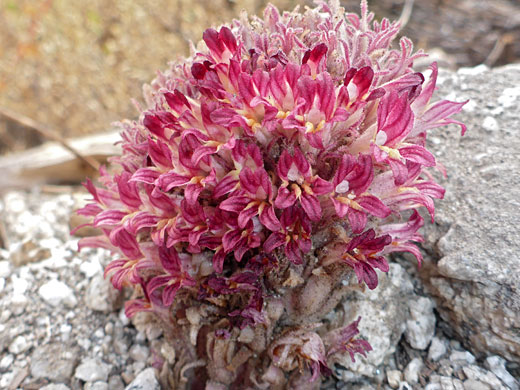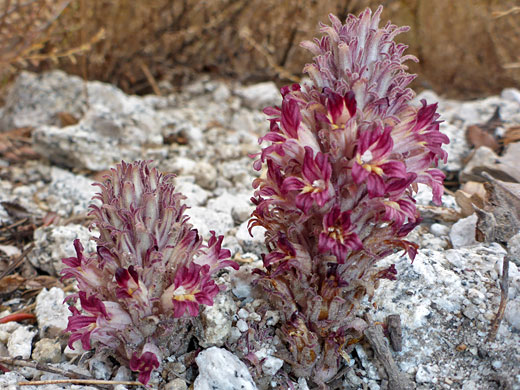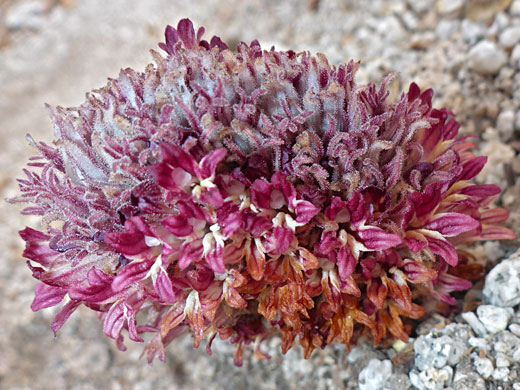Common name:
Flat-top broomrape
Family:
Scientific name:
Aphyllon corymbosum
Synonym:
Orobanche corymbosa
Main flower color:
Range:
Most common in Nevada, and the Sierra Nevada in California; other occurrences across most of the western states
Height:
Up to 6 inches
Habitat:
Sagebrush scrub, meadows; sandy or rocky places, from near sea level to 10,500 feet
Leaves:
Inconspicuous; ovate to broadly lanceolate, up to 0.3 inches long
Season:
to
Like all broomrape species, aphyllon corymbosum is parasitic, mainly on the roots of big sagebrush, artemisia tridentata. Plants have a few leaves low down on the stem, generally hidden by the inflorescence; they have wavy margins and (usually) short glandular hairs on the surface. The inflorescence may be a corymb, a flat-topped cluster, or a raceme, a more elongated cluster, or intermediate forms, but is usually dense, the flowers closely-spaced.
Flowers are attached by short stalks towards the base of the cluster, becoming sessile towards the top, and are subtended by two small bracts. The calyx is deeply divided into five narrow lobes, approximately equal in shape, up to one inch long - about the same length as, or slightly shorter than, the corolla. The calyx may be variously colored purple, pink, white or yellow, and it has a dense covering of glandular hairs. The corolla tube is white, pale pink or pale purple, while its lips are dark purple or reddish, orange-yellow along the lobe margins. Anthers are not exserted.
Two subspecies are ssp corymbosa, which has a more corymb-like inflorescence, longer calyces and glandular corollas, and ssp mutabilis, with more a elongated inflorescence, shorter calyces, and generally hairless corollas.
Flowers are attached by short stalks towards the base of the cluster, becoming sessile towards the top, and are subtended by two small bracts. The calyx is deeply divided into five narrow lobes, approximately equal in shape, up to one inch long - about the same length as, or slightly shorter than, the corolla. The calyx may be variously colored purple, pink, white or yellow, and it has a dense covering of glandular hairs. The corolla tube is white, pale pink or pale purple, while its lips are dark purple or reddish, orange-yellow along the lobe margins. Anthers are not exserted.
Two subspecies are ssp corymbosa, which has a more corymb-like inflorescence, longer calyces and glandular corollas, and ssp mutabilis, with more a elongated inflorescence, shorter calyces, and generally hairless corollas.
All Contents © Copyright The American Southwest | Comments and Questions | Contribute | Site Map






